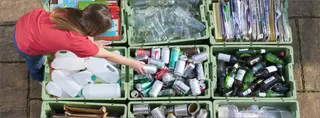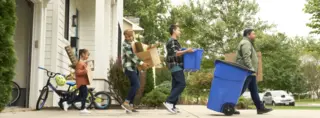
Customers are increasingly aware of the products they buy, and the materials used in their packaging. A recent study indicated that more than 80% of shoppers are concerned about plastic and packaging waste, preferring options that are easily recyclable and produce less waste.
The good news for customers and businesses alike is that packaging made from paper-based materials has come a long way. Customers love paper containers because they're designed to be beautiful, easily recyclable and compostable, and come from responsibly managed forests.
Businesses love paper containers, too, because they're designed to protect and preserve products, use less material, are easy to transport, sit efficiently on retail shelves, and can be cost-efficient. It's no wonder why nearly three quarters of adults in the U.S. say they prefer paper-based packaging for everyday products.
Recycling fiber-based materials is easy.
With global retail ecommerce sales projected to reach $8.1 trillion USD by 2026, an increasing number of packages will be shipped this year and in years to come. Yet, with so many cardboard boxes delivered to homes and businesses, two in three consumers confess to not always recycling, according to the Paper and Packaging Board.
"Only 40% of the corrugated boxes shipped to our homes in America are getting recycled. This is hampering our ability to produce new boxes from old boxes because we are not encouraging consumers to break down these boxes and put them in a recycling bin," says Greg Tucker, CEO of Bay Cities, a packaging and display company.

Paper and paper products, like packaging and boxes, are made from tree fiber—a resource that is renewable because trees naturally regenerate and are continually planted to meet business and consumer needs. The fibers that are recovered from recycling can be reused for new products and can be recycled up to seven times, the Paper and Packaging Board says.
The Box to Nature graphic offers consumers easy instructions that are specific to recycling fiber-based packaging (empty, flatten, recycle). The Paper and Packaging Board recommends placing the graphic where consumers are likely to see it, like the top flap of a box.
Consumers can also scan a QR code that takes them to Box2Nature.org. There, they will see an animated Thank You message and will be prompted to take an interactive quiz and learn more about recycling.
A simple step toward serious impact.
According to Paper and Packaging Board, 75% of consumers surveyed agree they would be more likely to recycle after seeing the Box to Nature message.
"As a box manufacturer, we are excited to participate in the Box to Nature program, reminding consumers at 'point of package' to empty, flatten and recycle," says Bryan Hollenbach, Executive Vice President at Green Bay Packaging. "This is an important industry initiative that will help improve residential recycling rates."
Adding the Box to Nature graphic to secondary packaging should come at little to no extra cost, Paper and Packaging Board says. "This is an industry supported program with the goal to spread this important recycling message on as many boxes as possible," says Mary Anne Hansan, President of the Paper and Packaging Board.
Click here to learn more about the Box to Nature initiative and how you can take part.



